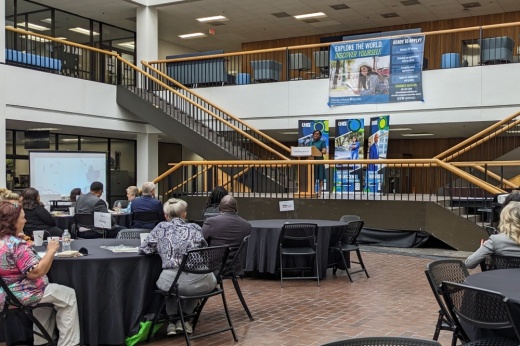NASA has its sights set on building a lunar base before sending astronauts from the moon to Mars, and other space industry developments are ongoing.
Johnson Space Center Director Vanessa Wyche shared several space-related updates during a luncheon April 26 at the University of Houston-Clear Lake.
“We really do have a renaissance happening right now in space and space exploration,” Wyche said.
For one, NASA earlier in April announced the four astronauts slated for Artemis 2, the first mission in 50 years that will bring humans within close vicinity to the moon. The mission will be a lunar flyby to prepare for humans to again walk on the moon, Wyche said.
NASA also recently celebrated the 60th anniversary of President John F. Kennedy’s moon speech at Rice University. Over 45,000 students attended the event, Wyche said.
Wyche also said she signed an agreement with UHCL to formalize and make an umbrella for ongoing partnerships between NASA and higher education institutions. NASA also recently completed its DART mission, which involved crashing a spacecraft into an asteroid to change its orbit, proving NASA could prevent asteroids “from killing all of us,” Wyche said.
For about the past 10 years, NASA could not launch astronauts from U.S. soil to the International Space Station and instead had to launch from other countries. The Commercial Crew Program changed that, allowing SpaceX and soon Boeing to launch NASA astronauts to the ISS, Wyche said.
Axiom Space, which has a presence at the Houston Spaceport, has been awarded three missions to the ISS, one of which was recently completed and another of which is scheduled for launch in May. Boeing is building its Starliner spacecraft to give NASA more capability to launch astronauts from Florida as early as this summer, Wyche said.
The ISS will stay in commission until 2030, after which it will be decommissioned, but NASA doesn’t plan to lose access to low Earth orbit. Axiom, Northrop Grumman, Nanoracks and Lockheed, and Blue Origin and Sierra are all developing private space stations that will allow NASA to continue to test and research close to home before moving onto the moon and Mars, Wyche said.
The Johnson Space Center is responsible for Orion, the new spacecraft that will be part of the Artemis missions, and Gateway, a space station that will orbit the moon similar to the ISS orbiting Earth. The Gateway will allow astronauts to move between it and the moon and eventually onto Mars, Wyche said.
On the moon, NASA will build a lunar base that will allow astronauts to “live off the land” and create rocket fuel before moving onto Mars, she said.
Axiom and Collins Aerospace, which also has a spaceport presence, have been contracted to make NASA’s next generation of spacesuits—the first suits designed for lunar exploration since the 1980s, Wyche said.
NASA is also developing lunar terrain vehicles, or moon buggies, that, unlike the ones of the Apollo era, will be autonomous when astronauts aren’t driving them, Wyche said.
Additionally, NASA has a commercial lunar payload services program in which private companies deliver lunar landers to the moon loaded with NASA payloads to conduct research. Intuitive Machines, which also has a spaceport presence, is one such company and plans to launch its first payload to the moon in June, Wyche said.
With so many missions in the works, Wyche acknowledged they might not all succeed, which is why NASA is being so methodical in its approach.
“These are very, very risky missions we’re about to go on,” she said.
For 60 years, Johnson Space Center has been the leader of space exploration, but today, there are so many entities going to space, from private astronauts, such as the ones Axiom has launched, to commercial companies. Wyche said NASA is interested in working with anyone trying to reach space.
“NASA has a responsibility for providing our facilities, our experts to make anyone who’s interested in going into space ... be successful,” she said.





